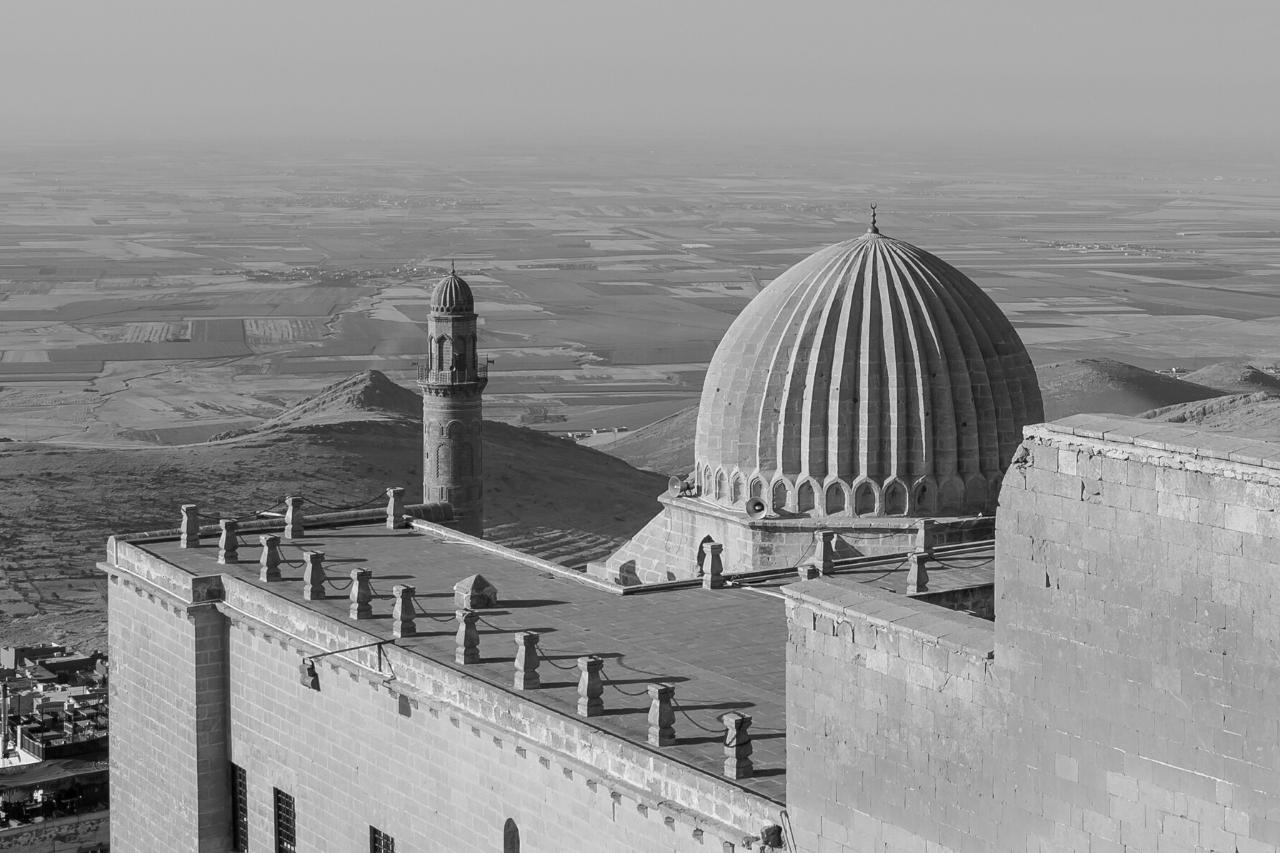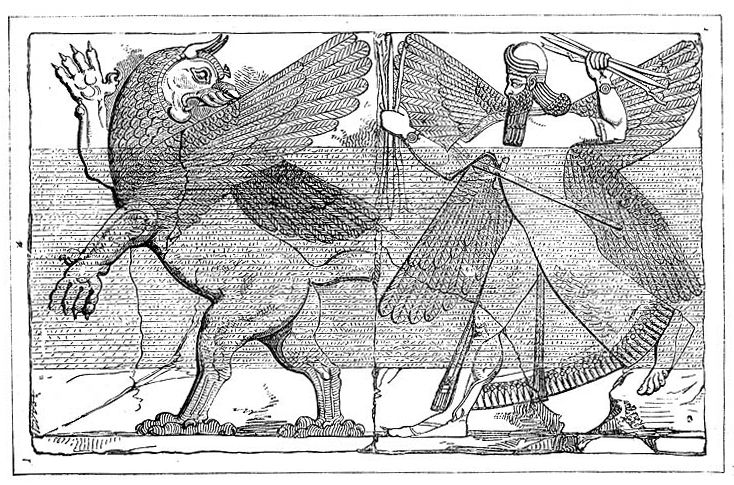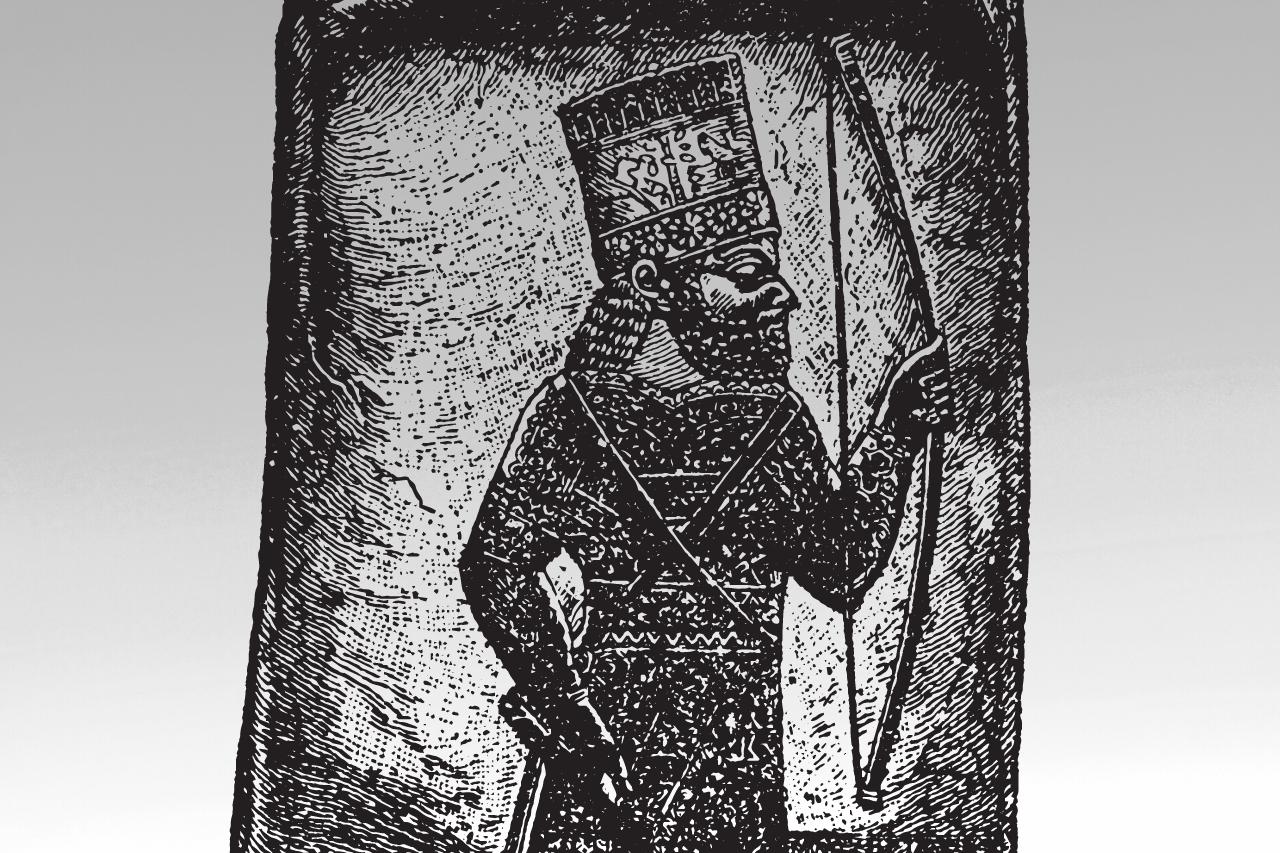Marduk: The Ancient Mesopotamian God Who Created Man
Marduk was an ancient agricultural god from the third millennium BCE who went on to become one of the most important gods of the Mesopotamian pantheon in the first millennium. He became notable after the event that made him head of the gods, and he has been credited with the creation and order of humanity. He had many names, each one a representation of his many traits as the supreme god.
Check this article about Marduk, to get a better insight into how he is comparable to Zeus/Apollo in Greek mythology and Jupiter in Roman mythology.
Who Is Marduk?
Marduk is an ancient Mesopotamian god who ascended through the ranks of the Babylonian pantheon to become one of the most powerful gods. Babylon became the epicenter of the Euphrates Valley during the Hammurabi period, about the 18th century BCE. By the second millennium BCE, he had become the patron god of Babylon, and his temple, the well-known ziggurat, is thought to have inspired the biblical Tower of Babel.
He was known in the first century as Bel, which means “Lord” in Akkadian, although his name translates to “bull-calf.” Marduk was a god with 50 different names, each one denoting a divine trait. His supremacy over the other gods began when he defeated Tiamat, goddess of the sea, earning him the nickname “warrior god.”
Marduk was associated with the planet Jupiter in Babylonian astrology. In addition, he was identified as the equivalent of Zeus or Apollo in Greek mythology for the Babylonian pantheon and Jupiter himself in Roman mythology.
Marduk’s Genealogy
The family tree of the Babylonian gods shows Apsu and Tiamat as primordial beings. Their offspring, Lahmu and Lahamu, were followed by Anshar and Kishar, Anu and Antu, and finally Enki and Damkina. Marduk was the son of Enki (who was also called Ea, the god of wisdom) and Damkina (or Damgalnuna). Asaruludu or Asalluhi was his brother, but it was syncretized with him and has become one of his 50 names.
Marduk’s main consort was the goddess of birth named Sarpanit (also known as Zarpanit, Sarpanitu, Zerbanitu, Zirpanet, Sarpanitu, Zerbanitu, and Zerpanitum). She was already recognized as Marduk’s divine wife before he rose to become the highest of all the gods. Some sources mistook Sarpanit for Ishtar, leading to the assumption that Marduk and Ishtar were married. Nabu, the patron god of scribes, was Marduk and Sarpanit’s son.
Symbols of Marduk
Marduk is often depicted wielding a triangular spade or hoe in his earliest monuments; such symbolism was taken to show fertility and greenery. He’s also shown walking or riding on his battle chariot. His clothing is usually embroidered with stars, and he wields a scepter, along with a bow, spear, net, or thunderbolt.
Inscriptions honoring Marduk and Zarpanitu were also found in Assyria and Persia, and several of their temples were renovated. The divine weapon Imhullu is linked to Marduk.
Marduk’s star was Jupiter, and his sacred animals were horses and hounds. However, the symbol that is most commonly associated with Marduk is the mushhushshu, which was a heavenly creature. Its name means “furious snake,” and the appearance of the animal’s body is made up of a snake’s head and scales, an eagle’s claws, a lion’s legs, and a scorpion’s stinger. On Babylon’s Ishtar Gate, this mushhushshu was one of the protective animal figures.
Place of Worship for Marduk
Between the second and first millennia BCE, when Babylon became the religious center of Mesopotamia, it also became the principal cult site for the chief Babylonian god, Marduk. He had a lot of temples, but the most famous were the Esagila and Etemenanki.
Esagila was Babylon’s most prominent temple complex. It was located south of Etemenanki, a massive ziggurat that measured 660 feet (200 meters) on its longest side and had three wide courtyards ringed by elaborate rooms.
A ziggurat is a pyramidal stepping temple tower made of mud bricks with a brick façade, which is an architectural and religious structure. The biblical “Tower of Babel” is claimed to have been modeled by this Marduk temple tower.
Marduk in the Bible
Not only is Marduk’s temple tower claimed to be connected with the Bible, but the Bible also references Cyrus the Great of Persia’s activities as being inspired by Marduk when Jews were exiled to Babylon. Rather than continuing his predecessor’s policy of destroying Babylonian temples and enslaving their priests, Cyrus declared the religious cults restored and even gave financial aid to help repair the temples.
Other biblical references include Marduk’s triumph over Tiamat, which was connected with Yahweh’s victory over the sea monster Leviathan. In addition, the Bible mentions “Merodach,” a Hebrew equivalent of Marduk that was used as a surname by a Babylonian king.
Furthermore, the story “Bel and the Dragon,” recorded in the Book of Daniel, tells the story of prophet Daniel exposing the Bel-Marduk priests’ lie. These criminals pretended to be an idol who ate a lot of food and enriched themselves and their families.
Marduk in Enuma Elish
Marduk was the designated gods’ champion who was responsible for the order and creation of the world in the Babylonian story Enuma Elish. This story, also known as The Seven Tablets of Creation, dates back to around 1200 BCE. It is considered one of the world’s oldest stories as it is about the birth of the gods and the creation of the universe and man.
First Tablet of Creation
The story begins before the creation when no other creatures or gods existed. There was just water, which was divided into two types: freshwater, which was known as the god Apsu, and salty, bitter water, which was known as the goddess Tiamat. Lahmu and Lahamu, the younger gods, were born from their union. Then came Anshar and Kishar, who gave birth to the god Anu, who in turn gave birth to Ea.
Tiamat adored her children, but Apsu was irritated because the young gods were so noisy that they kept him awake at night and disrupted his work in the morning. Apsu decided to kill the young gods on the counsel of Mummu, his vizier. When Tiamat learned of this, she notified Ea, who then put Apsu to sleep and killed him. Ea grabbed Apsu’s halo and made a dwelling place out of Apsu. Together with Damkina, they created Marduk.
Tiamat’s love for her children was replaced with fury when she learned of Apsu’s death. She sought advice from the god Kingu, who told her to wage war against her children. Tiamat summoned 11 monsters and appointed Kingu as her champion to command the war. She also made Kingu her new consort and gave him the “Tablet of Destinies.”
Second Tablet of Creation
When Ea learned of Tiamat’s plan to attack and get revenge for Apsu's death, he immediately informed Anshar and the other gods. They were worried that Kingu and the monsters would be invincible because Kingu possessed the “Tablet of Destinies.” They believed that no god could stand up to Tiamat and her monsters.
Anshar proposed that Marduk be their champion to battle Tiamat. Marduk was summoned, and he agreed on the condition that if he won, he would be declared the supreme god.
Third Tablet of Creation
The gods were unwilling to agree with Marduk’s condition, so Anshar went to Lahmu and Lahamu for advice, telling them about the situation with Tiamat, as well as Marduk’s condition. Lahmu and Lahamu, like the other gods, were concerned, but they drank together until they were drowsy and eventually approved of Marduk’s condition.
Fourth Tablet of Creation
When all the gods approved of Marduk’s condition to fight Tiamat, he was given a throne, a scepter, and a robe. He was also given weapons to use against Tiamat, such as a bow, a mace, a quiver, lightning bolts, and four winds.
Marduk used the four winds to trap Tiamat, and by adding a whirlwind, a cyclone, and Imhullu or the Evil Wind, Marduk stirred Tiamat. He advanced on his battle chariot drawn by four monsters and confronted Tiamat, who was outraged and challenged him to single combat.
Tiamat was then caught in a net by Marduk, and as she tried to swallow him, the Evil Wind filled her mouth. Finally, Tiamat became inflated as the winds whirled within her, and Marduk shot an arrow into her heart, killing her.
The 11 creatures she unleashed were also captured, and Kingu’s Tablet of Destinies was taken away from him before he was brought to the Angel of Death. Marduk then divided Tiamat’s remains in half, creating the sky from one half and creating places for Anu, Enlil, and Ea in the other.
Fifth Tablet of Creation
Marduk etched the formation of the constellation on the basis of the figures of the gods. These constellations helped them in determining the days of the years. Marduk also created the day and night. He also made the clouds rain, in which the water formed the rivers of Tigris and Euphrates. Afterward, he gave the “Tablet of Destinies” to Anu. The statue of Tiamat’s 11 monsters was made and placed at Apsu’s gates.
Sixth Tablet of Creation
After the creation of the sky, river, day, night, and Moon, Marduk told Ea that he would create a man with his blood. Its primary purpose is to serve the gods. Ea proposed that instead of using Marduk’s blood, they needed to sacrifice a god and use that blood instead of his. Kingu was chosen, and man was created from his blood.
Marduk focused on the assignment of the gods. They were divided into two groups: gods of above and gods of below. He assigned 600 gods on earth and 300 gods in the heavens. These gods offered to build a shrine for Marduk, but he told them to build Babylon instead. So, the gods spent almost a year making bricks and building the Esagila or the Temple of Marduk to a considerable height, providing a home for Marduk, Ea, and Enlil.
It was also in this tablet that the first nine names or titles were given to Marduk. These are Marduk, Marukka, Marutukku, Barashakushu, Luggaldimmerankia, NariLuggaldimmerankia, Asaruludu, Namtillaku, and Namru (Marduk’s 50 Names, n.d.).
Seventh Tablet of Creation
The seventh tablet of creation lists the remainder of the 50 names and titles given to Marduk. Starting from the 10th name, these are Asaru, Asarualim, Asarualimnunna, Tutu, Ziukkinna, Ziku, Agaku, Tuku, Shazu, Zisi, Suhrim, Suhgurim, Zahrim, Zahgurim, Enbilulu, Epadun, Enbilulugugal, Hegal, Sirsir, Malah, Gil, Gilma, Agilma, Zulum, Mummu, Zulummar, Lugalabdubur, Pagalguenna, Lugaldurmah, Aranunna, Dumuduku, Lugalanna, Lugalugga, Irkingu, Kinma, Esizkur, Gibil, Addu, Asharru, Nebiru, and Ninnuam (Marduk’s 50 Names, n.d.).
In this version of the story, the Sumerian god Ea, Enki, or Enlil played an important role, but Marduk was the champion of the young gods. As customary in Mesopotamian cities, their patron god was shown prominently as it was always thought to be the best and most powerful in their copies. Because the majority of the manuscripts are from Babylonian scribes, it is understandably in favor of their Babylonian god Marduk.
Prophecy of Marduk
The “Marduk Prophecy,” also known as the “Sulgi Prophecies,” is an ancient Assyrian text that describes Marduk’s voyages to the territories of the Hittites, Assyrians, and Elamites. It also contains a prediction of a future monarch who would guide Marduk back from Elam.
According to historians, the document dates back between 713 and 612 BCE. It was found in a building near a temple in Ashur, the first capital of the Assyrian Empire. Scholars believed it was created on purpose to be used in propaganda during King Nebuchadnezzar I’s reign as it directly correlates with Nebuchadnezzar I’s victory over the Elamites. He also transported the monument back to Babylon, as predicted by the prophecy.
Marduk as Babylon’s Patron
Despite being the son of a god from the gods’ middle tier, Marduk was not as important or celebrated as a patron until after the events detailed in Enuma Elish. He became well-known afterward. He rose to become the most powerful and well-known god in the Mesopotamian pantheon, not only in Babylon. The people’s love had almost reached monotheistic proportions.
From 1792 BCE to 1750 BCE, Marduk rose to prominence as the patron god of Babylon. He continued to be adored until the city was destroyed by Xerxes the Great in 485 BCE. Xerxes brought massive destruction to Babylon and removed the statue of Marduk from Esagila. It was believed that when a god’s statue was taken down, the protection it provided would be gone as well.
The gods were considered to be residing at their temples as long as their statues remained present. Because the god’s presence was believed to have vanished with the statue, the Babylonians were unable to celebrate the Akitu festival, which was crucial to the entire cultic year.
The Akitu Chronicle, an old document portraying a time of civil war when the Akitu festival (New Year’s celebration) could not be held because the statue of Marduk was not present in the city, recounted this. It was customary for people to move Marduk’s statue around the city and outside the city gates on New Year’s Day.
Conclusion
In the first millennium BCE, the Mesopotamian god Marduk rose from being a minor god in the third millennium BCE to becoming one of the most powerful gods and the head of the Mesopotamian pantheon.
Let us take a look at what we have discovered about him:
Marduk was known simply as “Bel,” which is an Akkadian word that means “Lord,” but his name translates to “bull-calf.” Aside from this, he was known to have 50 names, each one describing a divine trait.
Marduk was the Babylonian equivalent of Zeus/Apollo and Jupiter in Greek and Roman mythology, respectively. He was the son of Ea (god of wisdom) and Damkina. Her main consort was Sarpanit, to whom he had a son named Nabu (patron god of scribes).
The symbol most commonly associated with Marduk is the mushhushshu, a heavenly creature with the appearance of the animal’s body that is made up of a snake’s head and scales, an eagle’s claws, and a lion’s legs, and a scorpion’s stinger.
Marduk has many biblical connections, one of which is his temple tower, a ziggurat. It was said that the Tower of Babel was based on it. Enuma Elish was the Babylonian’s story of creation, and it also contains the list of Marduk’s 50 names. It was also known as “The Seven Tablets of Creation.”
The Marduk Prophecy is an ancient record that details Marduk’s journey to Elam, as well as a prophecy about a ruler who would lead him home. It was supposed to have been made for the propaganda of Nebuchadnezzar I.
The story behind Marduk’s genealogy, symbols, and role in Enuma Elish gave us a glimpse of this powerful god’s character, which also revealed connections to some of the mentioned references in the Bible. All of these were based on the written documents found by historians and scholars, and they give us a new perspective on how the world and men were created according to Babylonian mythology and how the importance of a god’s statue affected the celebration of festivities.













